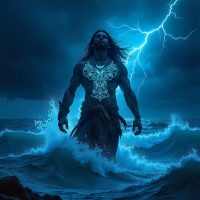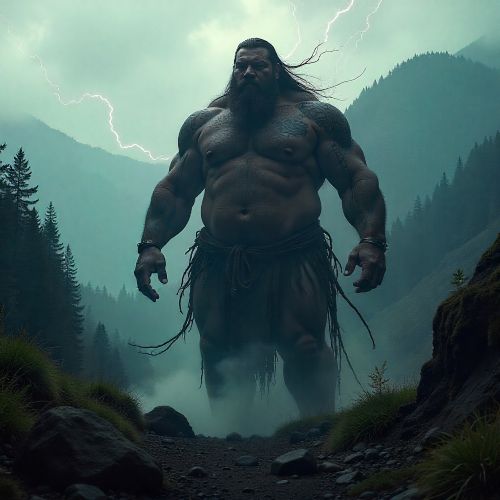Kapoonis : The Coast Salish Spirit of Lightning and Storms
Listen
At a glance
| Description | |
|---|---|
| Origin | Coast Salish Mythology |
| Classification | Mortals |
| Family Members | Enumclaw (Brother) |
| Region | United States of America, Canada |
| Associated With | Lightning |
Kapoonis
Introduction
Kapoonis is a significant figure in the mythic traditions of the Coast Salish peoples of the Pacific Northwest, remembered as the spirit who embodies the power and brilliance of lightning. His story is closely intertwined with that of his twin brother, Enumclaw, the spirit of thunder, forming one of the most enduring explanations of storm forces in Salish cosmology. According to oral histories, both brothers once lived as humans with a strong desire to become great healers. Their abilities grew so rapidly—and with such intensity—that Sky Father intervened, transforming them into storm spirits to restore balance to the world. In this way, Kapoonis became the manifestation of lightning, the sharp and luminous energy that cuts across the sky. His myth reveals the deep spiritual connection the Coast Salish place on natural events, viewing lightning not only as a physical occurrence but also as a message-bearing phenomenon that holds moral, ecological, and cosmic significance.
Physical Traits
Kapoonis is not described as a human-like deity but as a being of pure energy whose presence is defined by the visual and symbolic qualities of lightning. Instead of a solid form, he moves as flashes of incandescent light—quick, powerful, and unpredictable. Stories portray him as a radiant spirit whose essence glows like fire intensified by celestial force. The streaks of lightning across the sky are seen as the marks of his movement, and the sudden brightness of a storm is interpreted as Kapoonis revealing himself. This fiery radiance reflects his mastery over immense energy, with each flash representing the speed and precision that characterizes his nature. Some narratives imagine him with a fiery aura or a glowing figure at the core of the lightning, blending physical imagery with elemental symbolism. These traits reinforce his association with illumination, transformation, and raw natural power.
Family
Kapoonis’s closest familial tie is with his twin brother, Enumclaw, who represents thunder. The twins embody forces that naturally occur together, mirroring the simultaneous rumble and flash of a storm. Their shared origin as humans aspiring to spiritual mastery binds them in a narrative of growth, ambition, and cosmic consequence. Sky Father, who transformed them, plays the role of a divine guardian whose intervention shapes their destinies and anchors them within a greater network of spiritual beings. Through this relationship, the myth expresses the importance of duality in Coast Salish storytelling. Thunder provides the voice of the storm, signaling presence and warning, while lightning delivers illumination and power. Together, Kapoonis and Enumclaw represent balance—sound and light, force and brilliance—expressing how natural elements are interdependent and inseparable in Salish worldview.
Other names
Kapoonis is primarily known by this name within Coast Salish traditions, especially among communities such as the Snoqualmie. He is often referred to descriptively as the Lightning Spirit, emphasizing his domain rather than offering alternate titles. Variations may emerge in different Salish-speaking communities due to linguistic diversity, yet the core identity remains consistent: Kapoonis is the spirit who embodies lightning. Though parallels exist between him and storm-associated beings in other Indigenous cultures, such as lightning birds or thunder beings, these comparisons are symbolic rather than literal. Kapoonis retains a distinctly Coast Salish identity shaped by regional landscapes, ecological rhythms, and cultural teachings.
Powers and Abilities
Kapoonis’s abilities center entirely on his dominion over lightning and fire. Before his transformation, stories describe him as possessing an exceptional talent for controlling flames—a skill that foreshadows his eventual ascension as a lightning spirit. After becoming Kapoonis, his power magnifies beyond physical fire, evolving into celestial lightning capable of splitting the sky with sheer brilliance. His strikes are instantaneous, emphasizing his unmatched speed and precision. Lightning, within many Salish interpretations, is also a medium of communication, carrying messages from the spirit world or serving as a sign of divine presence. In this sense, Kapoonis is not only a force of nature but also a spiritual intermediary whose flashes can reveal guidance or warnings. His powers function in harmony with Enumclaw’s thunder, combining sound and light to create a complete storm force. Together, they regulate natural cycles, influence weather, and remind humans of the need to respect the forces of the world.
Modern Day Influence
The influence of Kapoonis continues to be felt in Coast Salish communities through cultural revitalization, storytelling, art, and ecological teachings. His story is preserved in oral traditions that emphasize the deep connections between humans, spirits, and the natural environment. Educational programs, cultural gatherings, and community initiatives often include stories of Kapoonis and Enumclaw to help younger generations understand Salish cosmology. Artists incorporate lightning motifs inspired by Kapoonis into carvings, paintings, and contemporary visual works, linking traditional narratives with modern expression. In broader cultural conversations, Kapoonis is increasingly recognized for his role in illustrating Indigenous perspectives on environmental balance. His association with storms serves as a reminder of nature’s cycles and the importance of stewardship. The legacy of the twin spirits also appears indirectly in place names such as Enumclaw, Washington, anchoring the myth within geography and keeping the story alive in everyday life.
Related Images
Source
Onat, J. (Year). Legends of the Coast Salish.
Canadian Museum of History. (n.d.). Coast Salish peoples. Retrieved from https://www.historymuseum.ca/coast-salish
SFU Bill Reid Centre. (2017). The history of Coast Salish peoples on Burnaby Mountain. Retrieved from https://the-peak.ca/2017/02/the-history-of-coast-salish-peoples-on-burnaby-mountain/
Kiddle, Kids Encyclopedia. (n.d.). Enumclaw and Kapoonis facts for kids. Retrieved from https://kids.kiddle.co/Enumclaw_and_Kapoonis
Boas, F. (1991). The myths of the Northwest Coast Indians. University of Washington Press.
Collective authors. (2024). Indigenous storm spirits: An exploration of Northwest Coast myths. Journal of Indigenous Studies, 18(3), 45-67.
Erdoes, R., & Ortiz, A. (1984). American Indian Myths and Legends. Pantheon Books.
Miller, J. (1999). Native Peoples of North America: An Encyclopedia of Culture, History, and Threats to Survival. Routledge.
Bastian, D. (2015). Thunder and Lightning in Indigenous Mythologies. Journal of American Folklore, 128(509), 45–67.
Frequently Asked Questions
Who is Kapoonis in Coast Salish mythology?
Kapoonis is the lightning spirit in Coast Salish mythology and the twin brother of Enumclaw, the thunder spirit. He represents the brilliance, speed, and transformative power of lightning in the natural world.
What does Kapoonis look like?
Kapoonis is described not as a human figure but as a radiant, fiery presence made of lightning. His form appears in the bright flashes that illuminate the sky during storms.
What powers does Kapoonis have?
Kapoonis controls lightning and celestial fire. His strikes symbolize speed, illumination, and spiritual communication, often interpreted as signs from the spirit world.
How is Kapoonis connected to Enumclaw?
Kapoonis and Enumclaw are twin brothers transformed from humans into storm spirits. Kapoonis governs lightning while Enumclaw rules thunder, forming a balanced duo representing storm forces.
Is Kapoonis still significant today?
Yes. Kapoonis remains an important figure in Coast Salish storytelling, cultural education, artistic expression, and discussions on ecological harmony and Indigenous cosmology.






